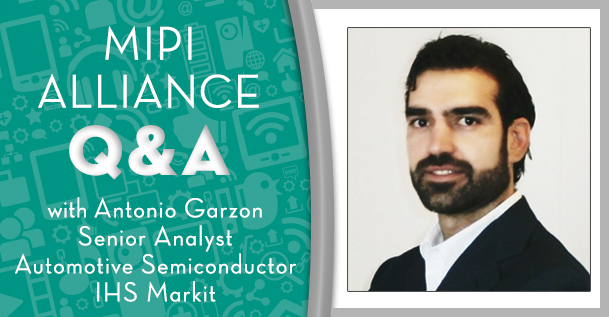2 min read
An Automotive Analyst’s Perspective – A Conversation with Antonio Garzón
![]() Sharmion Kerley, MIPI Director of Marketing and Membership
:
20 June 2019
Sharmion Kerley, MIPI Director of Marketing and Membership
:
20 June 2019

- News & Events
- News
- Blog
Q: Briefly, how would you characterize the current automotive electronics market?
Despite stagnant vehicle production levels around the world and the tariff war’s impact on the semiconductor markets, the proliferation of electronics found in cars will still continue to grow. This growth is boosted by the connectivity, electrification and autonomy trends that have been taking shape for several years. The current disruption of the vehicle architecture represents a great challenge for the whole automotive electronics supply chain, and we are already seeing a lot of movement with startups, mergers, acquisitions and interesting partnerships at every level.
Q: What is changing for OEMs? For SoC manufacturers and other suppliers?
Ground-breaking OEMs are going vertical by designing their own SoC for ADAS sensor fusion. Likewise, Tier 1s are becoming system integrators, focusing on functional safety and product reliability, and some semiconductor vendors are focusing on software, not only embedded, but also across the entire ecosystem, including AI platforms. In general, development times are adapting to the shorter consumer industry cycles, allowing for more frequent upgrades of software and hardware.
Q: You have talked about automobiles becoming “servers on wheels.” Can you elaborate on this concept and discuss the key drivers?
The introduction of domain and zonal controllers is a great opportunity to simplify the network topology and harnessing. It will happen gradually, depending on the vehicle segment and OEM strategy. From the basic function integration that started some years ago in the body gateway and the ECU consolidation seen today in the cockpit, the architectural evolution is progressing into domain fusion. ADAS, infotainment and telematics features are merging to enable not only basic safety-related applications such as instrument clusters, head-up displays and surround-view parking with electronic mirrors, but also soon will provide higher levels of autonomy using driver monitoring, V2X, high-definition maps, satellite and inertial navigation systems. The goal ultimately would be to connect all peripherals (sensors and actuators) to a main central computer and run most of the vehicle functions in the cloud. As a result, software development and integration is getting extremely complex and will soon become the highest cost of making a car.
Q: What are the key challenges for developers of ADAS and autonomous systems?
It is too expensive to train autonomous driving cars by driving millions of hours, so virtual simulations of the whole automotive environment and digital twins are necessary. This applies to the iterative ASIC design and verification process as well. In real driving situations, apart from the issue of sensor calibration, processing heterogeneous and often contradicting data will be a challenge for decision systems based on redundancy and arbitration mechanisms. Finally, I believe that explainable or transparent AI will be an essential characteristic of safety-critical autonomous cars.
Q: What role do standards and specifications play in this fast-changing space?
5G, IoT, cloud computing, cryptography and other major consumer and IT technologies will have a big influence in the automotive sector over the next decade. Using standard software and hardware solutions such as Linux, hypervisors, AUTOSAR, Ethernet, MIPI, USB, Bluetooth and Wi-Fi will be crucial for cybersecurity and to enable fast development in the increasingly dynamic automotive environment. There is great momentum building around open source business models, including hardware microarchitectures based on open instruction sets.
Antonio Garzon is a senior analyst for the IHS Markit automotive technology team. He conducts research and analysis on the automotive electronics and semiconductor markets with a special focus on infotainment, body electronics and advanced driver assistance systems (ADAS). He has worked in the infotainment departments of Seat, Aston Martin and BMW and as a test development engineer at NXP. Prior to that, he conducted research on artificial intelligence for Bosch, Sony, Telefónica and Fraunhofer.
Guest authors do not necessarily represent the opinions of MIPI Alliance.






